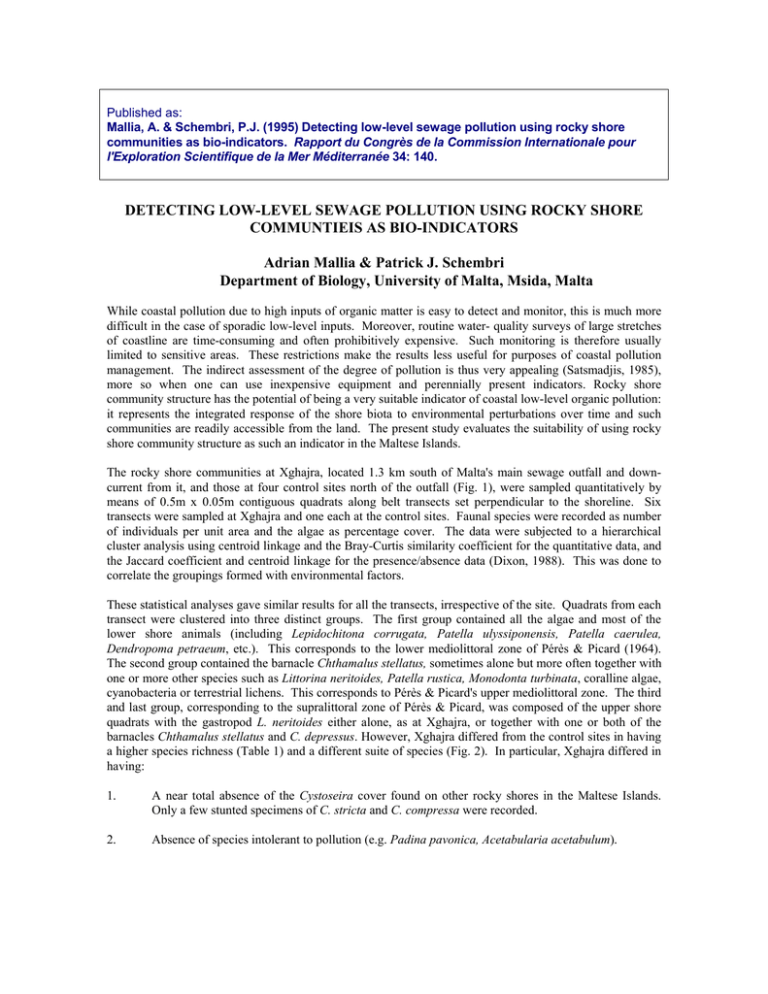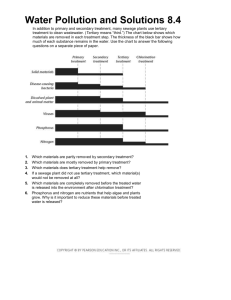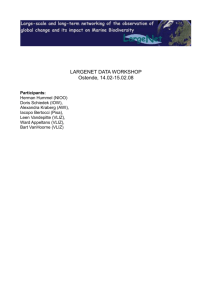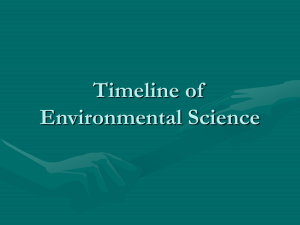Published as: Rapport du Congrès de la Commission Internationale pour
advertisement

Published as: Mallia, A. & Schembri, P.J. (1995) Detecting low-level sewage pollution using rocky shore communities as bio-indicators. Rapport du Congrès de la Commission Internationale pour l'Exploration Scientifique de la Mer Méditerranée 34: 140. DETECTING LOW-LEVEL SEWAGE POLLUTION USING ROCKY SHORE COMMUNTIEIS AS BIO-INDICATORS Adrian Mallia & Patrick J. Schembri Department of Biology, University of Malta, Msida, Malta While coastal pollution due to high inputs of organic matter is easy to detect and monitor, this is much more difficult in the case of sporadic low-level inputs. Moreover, routine water- quality surveys of large stretches of coastline are time-consuming and often prohibitively expensive. Such monitoring is therefore usually limited to sensitive areas. These restrictions make the results less useful for purposes of coastal pollution management. The indirect assessment of the degree of pollution is thus very appealing (Satsmadjis, 1985), more so when one can use inexpensive equipment and perennially present indicators. Rocky shore community structure has the potential of being a very suitable indicator of coastal low-level organic pollution: it represents the integrated response of the shore biota to environmental perturbations over time and such communities are readily accessible from the land. The present study evaluates the suitability of using rocky shore community structure as such an indicator in the Maltese Islands. The rocky shore communities at Xghajra, located 1.3 km south of Malta's main sewage outfall and downcurrent from it, and those at four control sites north of the outfall (Fig. 1), were sampled quantitatively by means of 0.5m x 0.05m contiguous quadrats along belt transects set perpendicular to the shoreline. Six transects were sampled at Xghajra and one each at the control sites. Faunal species were recorded as number of individuals per unit area and the algae as percentage cover. The data were subjected to a hierarchical cluster analysis using centroid linkage and the Bray-Curtis similarity coefficient for the quantitative data, and the Jaccard coefficient and centroid linkage for the presence/absence data (Dixon, 1988). This was done to correlate the groupings formed with environmental factors. These statistical analyses gave similar results for all the transects, irrespective of the site. Quadrats from each transect were clustered into three distinct groups. The first group contained all the algae and most of the lower shore animals (including Lepidochitona corrugata, Patella ulyssiponensis, Patella caerulea, Dendropoma petraeum, etc.). This corresponds to the lower mediolittoral zone of Pérès & Picard (1964). The second group contained the barnacle Chthamalus stellatus, sometimes alone but more often together with one or more other species such as Littorina neritoides, Patella rustica, Monodonta turbinata, coralline algae, cyanobacteria or terrestrial lichens. This corresponds to Pérès & Picard's upper mediolittoral zone. The third and last group, corresponding to the supralittoral zone of Pérès & Picard, was composed of the upper shore quadrats with the gastropod L. neritoides either alone, as at Xghajra, or together with one or both of the barnacles Chthamalus stellatus and C. depressus. However, Xghajra differed from the control sites in having a higher species richness (Table 1) and a different suite of species (Fig. 2). In particular, Xghajra differed in having: 1. A near total absence of the Cystoseira cover found on other rocky shores in the Maltese Islands. Only a few stunted specimens of C. stricta and C. compressa were recorded. 2. Absence of species intolerant to pollution (e.g. Padina pavonica, Acetabularia acetabulum). 3. A large number of pollution-tolerant species (e.g. Pterocladia capillacea, Corallina elongata, Gigartina acicularis, Ulva rigida, Enteromorpha spp. and Cladophora spp.). Thus, while the general zonation patterns at Xghajra were similar to those of the four control sites, the shore community here exhibited some peculiarities when compared to the rest, especially in the type of species present and in their abundance. The dominant algae at Xghajra formed associations characteristic of environments having high organic loading in the water as shown in other parts of the Mediterranean and the Red Sea (Cormaci et al., 1985; D'Anna et al., 1985; Ismail & Award, 1987; Cormaci & Furnari, 1991). The presence at Xghajra of a large population of filter-feeding bivalves (especially Mytilaster minimus) is also indicative of added nutrients in the water, as is the presence of a large number of polychaetes. The type of species, the species richness, their abundance, as well as their associations (especially those exhibited by the algae), at Xghajra, are unusual for Maltese rocky shores and to date have only been found in this area. These results suggest that rocky shore biotic assemblages may be useful indicators of low-level sewage pollution, at least under local conditions. REFERENCES Cormaci, M. & Funari, G. (1991) Phytobenthic communities as monitor of the environmental conditions of the Brindisi coastline. Oebalia 17 suppl. 1: 177-198. Cormaci, M., Funari, G., Giaccone, G., Colonna, P. & Mannino, A.M. (1985) Metodo sinecologico per la valutazione degli apporti inquinanti nella rada di Augusta (Siracusa). Boll. Acc. Gioenia Sci. Nat. 18(326): 829-850. D'Anna, G., Giaccone, G. & Riggio, S. (1985) Lineamenti bionomici dei banchi di mitili di Balestrate (Sicilia occidentale). Oebalia 11: 389-399. Dixon, W.J. (1988) [ed.] BMDP Statistical Software Manual. Vols I & II. Berkeley: University of California Press. Ismail, N.S. & Awad, J. (1987) Effects of sewage dumping on macrobenthic invertebrates in the Jordan Gulf of Aqaba, Red Sea. Int. Revue ges Hydrobiol. 72(2): 225-234. Pérès, J.M. & Picard, J. (1964) Nouveau manuel de bionomie benthique de la mer Méditerranée. Rec. Trav. Sta. mar. Endoume 18: 15-30. Satsmadjis, J. (1985) Comparison of indicators of pollution in the Mediterranean. Mar. Poll. Bull. 16(10): 395-400.






